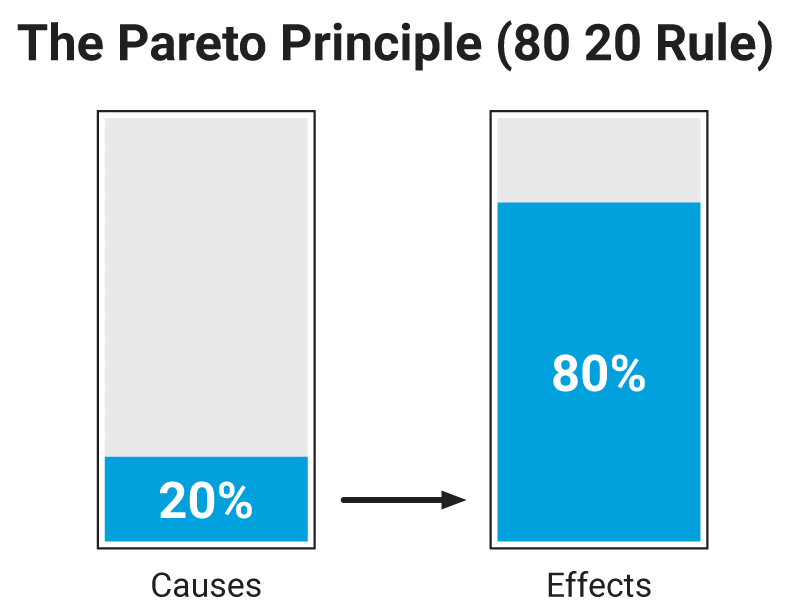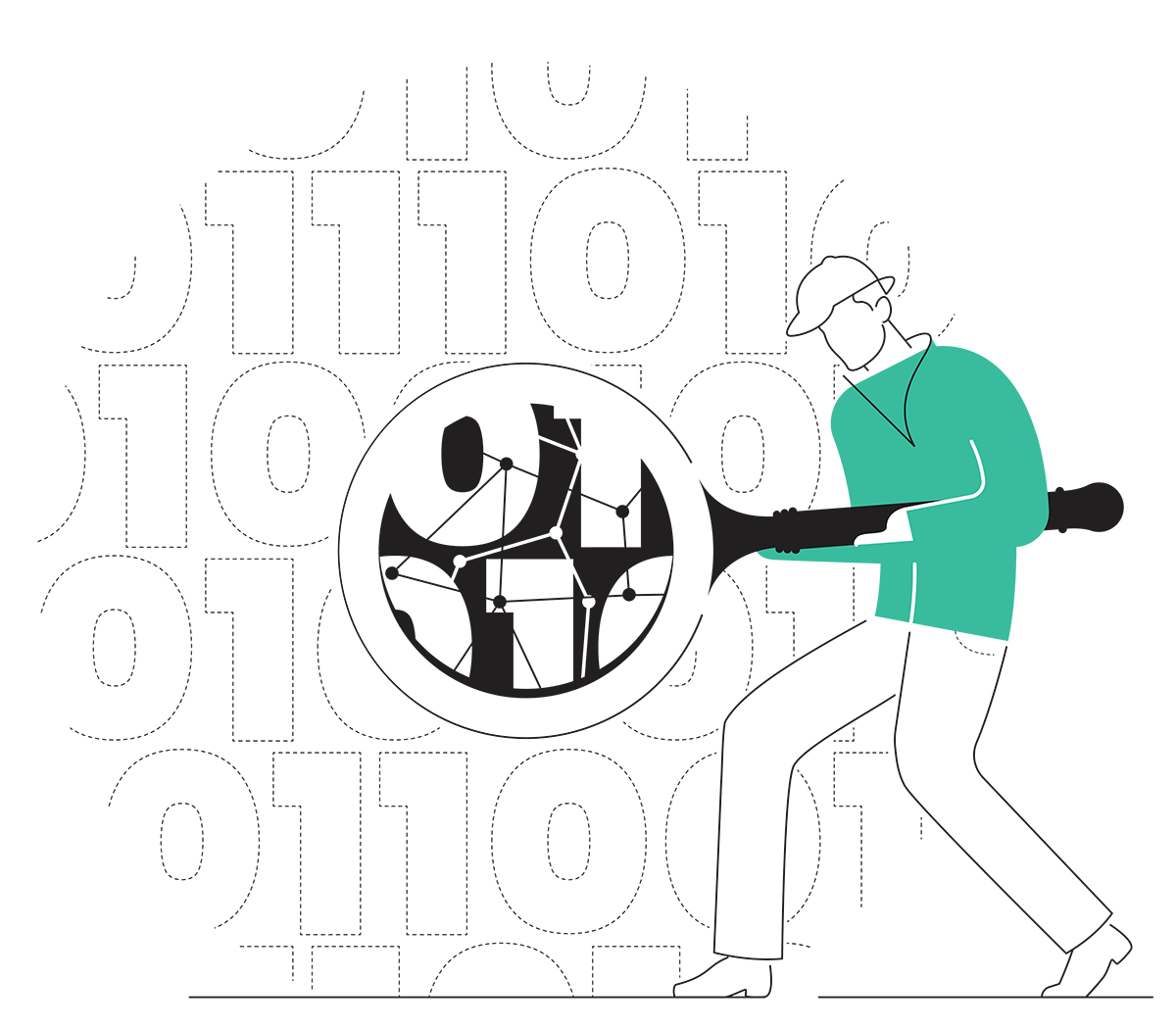The Pareto Principle.
If you find yourself dimly recalling these words, chances are it’s because you last heard them in a middle school or high school classroom.
Also known as the 80 20 rule, this is a principle that states that 80% of the effects come from 20% of the causes.

Which is all well and good in theory, but the question remains—how can you apply this rule to your business?
Well, what if we told you that in the world of sales and marketing, this principle can actually be used to identify the most effective strategies and tactics for generating leads and closing deals?
That would be pretty, cool, right?
Not to mention time saving.
Understanding and applying the Pareto Principle can help sales and marketing professionals like you to be more efficient and effective in their work and increase their overall productivity. That is exactly why, in today’s blog, we’re going to share some examples of exactly how to apply the Pareto Principle in order to find more success in your business.
Ready?
Let’s go!
The History of The Pareto Principle
First off, this fancy name comes from an Italian economist. His name was Vilfredo Pareto and he took note of the fact that 80% Italian land was owned by a mere 20% of the population. And that was back in late 19th century—so the concept has been around for a while.
But the actual Principal isn’t restricted to the idea of land. Rather, the Principle states that in any given situation, 80% of the effects come from 20% of the causes.
This means that a small number of causes are responsible for the majority of the results.
Pareto later found that this 80-20 distribution held true for many other areas of life including things like income distribution and even business productivity. Ultimately, this principle can be applied to a variety of areas like business, personal finance, and time management.
And, of course, sales and marketing!
Understanding the Pareto Principle in Sales and Marketing
When it comes to marketing a product or service, or trying to sell it, the Pareto Principle can be used.
How?
To identify the most effective channels for generating leads and closing deals. By identifying the top 20% of channels that generate 80% of the results, sales and marketing professionals can focus their efforts on these channels and increase their overall productivity.
Here are three examples of what that might look like to a business:

Identifying the most effective channels for lead generation
By using data to identify the top 20% of channels that generate 80% of leads, a business can focus its lead generation efforts on these channels and increase its overall productivity. For example, a business may find that 80% of its leads come from 20% of its social media channels. By focusing on these high-performing channels and investing more resources in them, the business can increase its lead generation.

Optimizing email marketing campaigns
By analyzing the data on email open and click-through rates, a business can identify the top 20% of email campaigns that generate the most results. By focusing on these high-performing campaigns and optimizing them, a business can increase its email marketing effectiveness.

Targeting the most profitable customer segments
By analyzing data on customer spending, a business can identify the top 20% of customer segments that generate 80% of revenue. By focusing on these high-value customer segments and tailoring its marketing efforts to them, a business can increase its overall profitability.
How the Pareto Principal Applies to Data
One of the key components of effectively applying the Pareto Principle in sales and marketing is having access to high-quality, accurate data.

Without accurate data, it is difficult to identify the top 20% of channels, sources, strategies, and tactics that generate the most results. But by using high-quality, accurate data, businesses can gain a deeper understanding of their customer base and target market, which can help them to identify new leads and opportunities.
Additionally, by using accurate data, businesses can identify patterns and trends that can inform their sales and marketing strategy, helping them to target their efforts more effectively. Overall, high-quality, accurate data is essential for businesses to make data-driven decisions.
Applying the Pareto Principle to Your Business
There are so many outstanding opportunities to apply this Principal to your business. Doing so can help you to be more efficient and effective in your work. By identifying the top 20% of causes that generate 80% of the effects, you can focus on the most important tasks and increase your overall productivity.
Additionally, by focusing on the most profitable products or services and streamlining processes, you can increase your overall profitability.
And, by applying the Pareto Principle, you can optimize your efforts and achieve better results. That’s because it will help you to identify the most important things to focus on, and by doing so, you can prioritize your time and resources effectively. As a result, you can achieve more with less effort and increase your business’s performance.
Don’t forget that the Pareto Principle can also help you to identify patterns and trends that can inform your business strategy. By using accurate data, you can identify the areas where you are succeeding and where you need to improve. This information is essential for making data-driven decisions that can improve your business’s performance over time.
Applying the Pareto Principle to Lead Generation
Using the Pareto Principle in regard to lead generation can help you to identify the most effective channels and sources for generating leads, and optimize your efforts to increase your lead generation. Here are four examples:

Increased Efficiency
By identifying the top 20% of channels and sources that generate 80% of leads, you can focus your lead generation efforts on these channels and sources and increase your overall productivity. This can help you to generate more leads with less effort and resources.

Better targeting
By identifying the most effective channels and sources for lead generation, you can also gain a better understanding of your target audience, and tailor your lead generation efforts to reach them more effectively.

Better ROI
By focusing on the most effective channels and sources for lead generation, you can also increase your return on investment. By allocating more resources to the channels and sources that generate the most leads, you can generate more leads and improve your ROI.

Improved conversion rates
By identifying the most effective channels and sources, you can also identify patterns and trends that can inform your lead generation strategy. This can help you to improve your conversion rates by targeting the right audience, at the right time and with the right message.
Applying the Pareto Principle to Closing More Deals
In closing deals, the Pareto Principle can be used to identify the most effective strategies and tactics. By identifying the top 20% of strategies and tactics that generate 80% of the deals, sales professionals can focus on these strategies and tactics and increase their overall productivity.
For example, a sales professional may find that 80% of their deals come from 20% of their customer interactions. By focusing on these interactions and investing more resources in them, the sales professional can increase their closing rate.
Applying the Pareto Principle to Cost Savings
For businesses that have little to no room for error when it comes to their bottom line, the Pareto Principle can be used to identify which expenses are responsible for the majority of a business’s spending.
Consider that using this rule, your business can identify the top 20% of expenses that make up 80% of your business’s spending, enabling you to focus on reducing or eliminating these expenses to save money.
Applying the Pareto Principle to Time Management
In the world of selling, time is absolutely money. So, it makes perfect sense to apply the Pareto Principle when talking about time management. Whether it be applied to your own work, or the work of your employees is up to you.
Consider that in regard to time management, the Pareto Principle can be used to identify which tasks are responsible for the majority of a person’s productivity. By identifying the top 20% of tasks that generate 80% of the results, a person can focus on completing these tasks first and increase their overall productivity.
The Pareto Principle is a powerful tool that can be used in the world of sales and marketing to increase efficiency and effectiveness. By identifying the top 20% of causes that generate 80% of the effects, your business will be able to focus on the most important strategies, tactics and channels and increase productivity and overall success.






